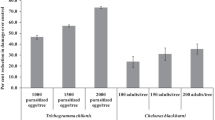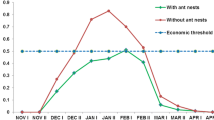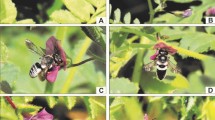Abstract
Cashew production in Tanzania is severely constrained by sucking insect pests such as the coreid coconut bugs (Pseudotheraptus wayi Brown), the mirid bugs, Helopeltis spp. and thrips spp. These pests damage flushing foliar and floral shoots as well as young cashew fruits and nuts. Farmers rely heavily on insecticides in controlling these pests and there are no suitable alternative control methods compatible with organic cashew production. Weaver ants, Oecophylla longinoda Latreille have for long been considered as effective biological control agents against sap-sucking pests of cashew, but studies on their effectiveness as compared to conventional insecticides had never been conducted. The current study evaluated the efficiency of O. longinoda as compared to the recommended conventional insecticide, lambda cyhalothrin (Karate®) in controlling major cashew insect pests and compared the resulting cashew yield. The damage caused by each pest was significantly lower (P < 0.0001) on trees with weaver ants and in the plots treated with Karate® than was the case on the control trees. There was no significant difference (P > 0.05) in the damage between O. longinoda and Karate® treated trees suggesting that the two treatments are equally effective. The difference in the damage levels was directly reflected in the mean cashew yield. The two season’s results showed an average yield increases of 58.2 and 60.7 % in the insecticide-treated and in the O. longinoda-protected trees, respectively, in relation to untreated control plots. Thus, O. longinoda can serve as an alternative to chemical insecticides in Tanzanian cashew protection.




Similar content being viewed by others
References
Abdulla NR, Rwegasira GM, Jensen K-MV, Mwatawala MW, Offenberg J (2015) Control of mango seed weevils (Sternochetus mangiferae) using the African Weaver Ant (Oecophylla longinoda Latreille) (Hymenoptera: Formicidae). J Appl Entomol [http:/onlinelibrary.wiley.com/doi/10.1111/jen.12260.pdf ] Accessed 20/8/2015.
Anato FM, Wargui R, Sinzogan A, Offenberg J, Adandonon A, J-F Vayssières, Kossou D (2015) Reducing losses inflicted by insect pests on cashew, using weaver ants as a biological control agent. Agric For Entomol [http://onlinelibrary.wiley.com/doi/10.1111/afe.12105/pdf] Accessed 05/3/2015.
Azam-Ali SH, Judge EC (2006) Small-scale cashew nut processing. ITDG Schumacher Centre for technology and development. Bourton on Dunsmore, Rugby, Warwickshire. 70 pp
Dwomoh EA, Afun JV, Ackonor JB, Agene VN (2009) Investigations on Oecophylla longinoda (latreille) (hymenoptera: formicidae) as a biocontrol agent in the protection of cashew plantations. Pest Manag Sci 65:41–46. doi:10.1002/ps.1642
Egonyu JP, Ekesi S, Kabaru J, Irungu L (2014) Biology of the coconut bug, Pseudotheraptus wayi, on French beans. J Insect Sci 14(44):1–6. doi:10.1673/031.014.44
Export promotion of organic products from Africa (EPOPA) (2004) Opportunities for domestic organic market in Tanzania. Bennekom. 30 pp
Fianko JR, Donkor A, Lowor ST, Yeboah PO (2011) Agrochemicals and the Ghanaian environment, a Review. J Environ Protec 2:221–230. doi:10.4236/jep.2011.23026
Igboekwe AD (1985) Injury to young cashew plants, Anacardium occidentale L., by the red-banded thrips, Selenothrips rubrocinctus Giard (Thysanoptera: Thripidae). Agric Ecosyst Environ 13:25–32. doi:10.1016/0167-8809(85)90098-2
Martin PJ, Topper CP, Bashiru RA, Boma F, De Waal D, Harries HC, Kasuga LJ, Katanila N, Kikoka LP, Lamboll R, Maddison AC, Majule AE, Masawe PA, Milanzi KJ, Nathaniels NQ, Shomari SH, Sijaona ME, Stathers T (1997) Cashew nut production in Tanzania: constraints and progress through integrated crop management. Crop Prot 16(1):5–14
Maruthadurai R, Desai AR, Prabhu HRC, Singh NP (2012) Insect Pests of Cashew and their Management. Technical Bulletin No. 28, ICAR Research Complex for Goa, Old Goa. 18pp.
NARI (2008) Cashew research programme annual report. Mtwara. 105 pp
NARI (2010) Annual cashew research report. Naliendele Agricultural Research Institute, Ministry of Agriculture, Food Security and Cooperatives. Mtwara. 23 pp
Offenberg J, Wiwatwitaya D (2010) Sustainable weaver ant (Oecophylla smaragdina) farming: harvest yields and effects on worker ant density. Asian Myrmecol 3:55–62
Offenberg J, Cuc NTT, Wiwatwitaya D (2013) The effectiveness of weaver ant (Oecophylla smaragdina) biocontrol in Southeast Asian citrus and mango. Asian Myrmecol 5:139–149
Offenberg J (2015) Ants as tools in sustainable agriculture. J Appl Ecol 52:1197–1205. doi:10.1111/1365-2664.12496
Olotu MI, du Plessis H, Seguni ZS, Maniania NK (2012) Efficacy of the African weaver ant Oecophylla longinoda (Hymenoptera: Formicidae) in the control of Helopeltis spp. (Hemiptera: Miridae) and Pseudotheraptus wayi (Hemiptera: Coreidae) in cashew crop in Tanzania. Pest Manag Sci 69(8):911–918. doi:10.1002/ps.3451
Olotu MI, Maniania NK, Ekesi S, Seguni Z, du Plessis H (2013) Effect of fungicides used for powdery mildew disease management on the African weaver ant, Oecophylla longinoda (Hymenoptera: Formicidae), a biocontrol agent of sap-sucking pests in cashew crops in Tanzania. Int J Trop Insect Sci 33(4):283–290. doi:10.1017/S1742758413000313
Oruonye ED, Okrikata E (2010) Sustainable use of plant protection products in Nigeria and challenges. J. Plant breed. Crop Sci 2:267–272
Ouagoussounon I, Offenberg J, Sinzogan A, Adandonon A, Kossou D, Vayssières J-F (2015) Founding weaver ant queens (Oecophylla longinoda) increase production and nanitic worker when adopting non nestmate pupae. SpringerPlus 4:6. doi:10.1186/2193-1801-4-6
Peng R, Christian K, Lan LP, Binh NT (2008) Integrated cashew improvement program using weaver ants as a major component. Manual for ICI program trainers and extension officers in Vietnam. Charles Darwin University and Institute of Agricultural Science for South Vietnam, 90 pp
Peng R, Lan LP, Christian K (2014) Weaver ant role in cashew orchards in Vietnam. J Econ Entomol 107(4):1330–1338 http://www.bioone.org/doi/full/10.1603/EC14039
Peng RK, Christian K (2004) The weaver ant, Oecophylla smaragdina (Hymenoptera: Formicidae), an effective biological control agent of the red-banded thrips, Selenothrips rubrocinctus (Thysanoptera: Thripidae) in mango crops in the Northern Territory of Australia. Int J Pest Man 50(2):107–114. doi:10.1080/09670870410001658125
Peng RK, Christian K (2005) The control efficacy of the weaver ant, Oecophylla smaragdina (Hymenoptera: Formicidae), on the mango leafhopper, Idioscopus nitidulus (Hemiptera: Cicadellidae) in mango orchards in the Northern Territory. Int J Pest Man 50(4):297–304. doi:10.1080/09670870500151689
Peng RK, Christian K (2008) Potential for organic mango production in the Northern Territory of Australia using weaver ants, Oecophylla smaragdina, (Hymenoptera: Formicidae). Acta Hort 767:81–87. doi:10.17660/ActaHortic.2008.767.7
Peng RK, Christian K, Gibb K (2011) The best time of day to monitor and manipulate weaver ant colonies in biological control. J Appl Entomol 136:155–160. doi:10.1111/j.1439-0418.2011.01651.x
Peng RK, Christian K, Reilly D (2010) Weaver ants, Oecophylla smaragdina (Hymenoptera: Formicidae), as biocontrol agents on African mahogany trees, Khaya senegalensis (Sapindales: Meliaceae), in the Northern Territory of Australia. Int J Pest Man 56(4):363–370. doi:10.1080/09670874.2010.503286
Pierre EM, Idris AH (2013) Studies on the predatory activities of Oecophylla smaragdina (Hymenoptera: Formicidae) on Pteroma pendula (Lepidoptera: Psychidae) in oil palm plantations in Teluk Intan, Perak (Malaysia). Asian Myrmecol 5:163–176
Ramesh P, Panwar NR, Singh AB, Ramana S, Yodav SK, Shrivastava R, Sabba Rao A (2010) Status of organic farming in India. Current Sci 98(9):1190–1194
Rwegasira RG, Mwatawala M, Rwegasira GM, Mogens GN, Offenberg J (2015) Comparing different methods for trapping mated queens of weaver ant (Oecophylla longinoda; Hymenoptera: Formicidae). Biocontrol Sci Tech 25(5):503–512. doi:10.1080/09583157.2014.992861
Saini RK, Yadav GS, Kumari B (2014) Compendium of lectures delivered during the Advanced Training Course on “Novel Approaches in Pest and Pesticide Management in Agro-Ecosystem”. 19th August to 8th September, 2014. In: Centre of Advanced Faculty Training (CAFT). CCS Haryana Agricultural University, Hisar, Department of Entomology, 338 pp
Seguni ZSK (1997) Biology and control of Pheidole megacephala (Hymenoptera: Formicidae, Myrmicinae) especially in relation to use of Oecophylla longinoda (Formicidae, Formicinae) for biological control of Pseudotheraptus wayi (Heteroptera: Coreidae) in Tanzanian coconut cropping systems. University of London, PhD Dissertation, 231 pp
Seguni ZSK, Way MJ, Van Mele P (2011) The effect of ground vegetation management on competition between the ants Oecophylla longinoda and Pheidole megacephala and implications for conservation biological control. Crop Protec 30:713–717. doi:10.1016/j.cropro.2011.01.006
MER Sijaona (1997) Studies on aspects of Cashew resistance to powdery mildew (Oidium anacardii Noack). PhD thesis. Wye College, University of London. 316 pp.
Smith DN, King WJ, Topper CP, Boma F, Cooper JF (2008) Alternative techniques for the application of sulphur dust to cashew trees for the control of powdery mildew caused by the fungus Oidium species in Tanzania. Crop Protect 14(7):555–560. doi:10.1016/0261-2194(95)00063-1
Sporleder M, Rapp G (1998) The effect of Oecophylla longinoda (Latreille) (Hymenoptera: Formicidae) on coconut palm productivity with respect to Pseudotheraptus wayi (Hemiptera: Coreidae) damage in Zanzibar. J Appl Entomo 122:475–481. doi:10.1111/j.1439-0418.1998.tb01530.x
Van Mele P (2008) A historical review of research on the weaver ant Oecophylla in biological control. J Agric for Entomol 10:13–22. doi:10.1111/j.1461-9563.2007.00350.x
Van Mele P, Cuc NTT (2007) Ants as friends: Improving your tree crops with weaver ants (2nd Edition). Africa Rice Center (WARDA), Cotonou, Benin, and CABI, Egham, U.K. 69 pp.
Van Mele P, Cuc NTT, Van Huis A (2002) Direct and indirect influences of the weaver ant Oecophylla smaragdina on citrus farmers’ pest perceptions and management practices in the Mekong Delta, Vietnam. Int J Pest Man 48(3):225–232. doi:10.1080/09670870110118713
Van Mele P, Vayssiéres J-F, Tellingen EV, Vrolijks J (2007) Effects of an African weaver ant, Oecophylla longinoda, in controlling mango fruit flies (Diptera: Tephritidae) in Benin. J Econ Entomol 100:695–701. doi:10.1603/0022-0493(2007)100[695:EOAAWA]2.0.CO;2
Varela AM (1992) Role of Oecophylla longinoda (Formicidae) in control of Pseudotheraptus wayi (Coreidae) on coconut in Tanzania. PhD dissertation. University of London. 238 pp
Way MJ, Khoo KC (1992) Role of ants in pest management. Annu Rev Entomol 37:479–503. doi:10.1146/annurev.en.37.010192.002403
William JG, Hella J, Lars E, Offenberg J, Mwatawala M, Rwegasira G (2015) Partial budgeting analysis of different strategies for management of insect pests in cashew and mango orchards in Tanzania. Int J Sust Agric Res 2(4):98–110
Acknowledgments
The authors would like to thank the Naliendele Agricultural Research Institute (NARI), Mtwara, Tanzania, for permission to conduct research in their cashew orchards and for the provision of technical assistance. Dr. Renkang Peng is acknowledged for technical assistance in differentiating symptoms caused by different cashew pests. Support from Hassan Libubulu, Hamza Mawazo, Mohammed Salim and Mohammed Machunja during the field activities and W. George during the initial stages of weaver ant transplantation is acknowledged.
Author information
Authors and Affiliations
Corresponding author
Ethics declarations
Funding
This study was funded by the Danish International Development Assistance (DANIDA) through Project number 10-025AU.
Rights and permissions
About this article
Cite this article
Abdulla, N.R., Rwegasira, G.M., Jensen, KM.V. et al. Potential of Oecophylla longinoda Latreille (Hymenoptera: Formicidae) in managing major insect pests in organic cashew production systems. Org. Agr. 7, 95–104 (2017). https://doi.org/10.1007/s13165-016-0152-8
Received:
Accepted:
Published:
Issue Date:
DOI: https://doi.org/10.1007/s13165-016-0152-8




